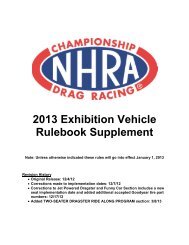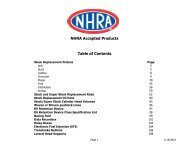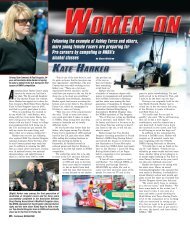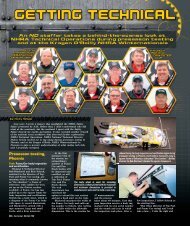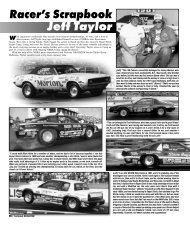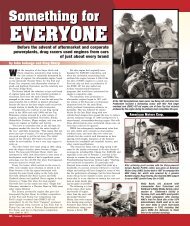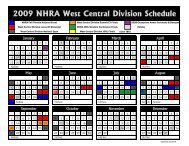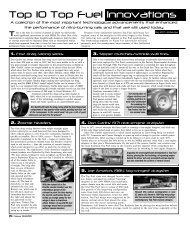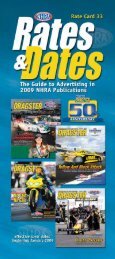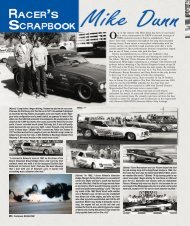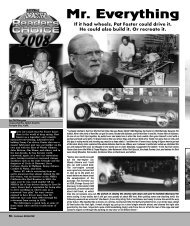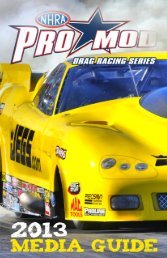Gas Ronda.pdf - NHRA.com
Gas Ronda.pdf - NHRA.com
Gas Ronda.pdf - NHRA.com
You also want an ePaper? Increase the reach of your titles
YUMPU automatically turns print PDFs into web optimized ePapers that Google loves.
The dapper former dance instructor put Ford on the racing map during<br />
the days of heads-up Super Stock racing and the early Funny Cars<br />
by John Jodauga<br />
During the 1970s and 1980s, Bob<br />
Glidden was the favorite of Ford<br />
drag racing fans with his near-total<br />
domination of Pro Stock, and John<br />
Force has shined in a similar role in<br />
Funny Car in the last two decades, but<br />
throughout the 1960s, the man who<br />
gave Ford fans the most reasons to<br />
cheer was <strong>Gas</strong> <strong>Ronda</strong>, the Super Stock<br />
standout who went on to play a major<br />
pioneering role in the early days of<br />
Funny Car racing.<br />
<strong>Ronda</strong> won the <strong>NHRA</strong> Top Stock<br />
championship in 1964, the year the<br />
class was introduced, and that played a<br />
major role in Ford winning <strong>NHRA</strong>’s<br />
first Manufacturers Cup. Later in the<br />
decade, he emerged as one of the<br />
strongest West Coast Funny Car<br />
campaigners. But in 1970, the same<br />
year the Pro Stock class was introduced,<br />
Rhonda’s driving career was<br />
ended prematurely after he suffered<br />
major burns from an engine fire. Many<br />
drag racing observers felt that <strong>Ronda</strong>’s<br />
skills with the four-speed transmission<br />
would have made him a superstar in<br />
Pro Stock.<br />
Another aspect that made <strong>Ronda</strong><br />
stand out from other racers was being<br />
one of the sharpest-dressed racers of<br />
his era. Much of that came from his<br />
days as a dance instructor when he<br />
lived in the San Francisco area in the<br />
1950s. After he began to rise up in the<br />
drag racing ranks, <strong>Ronda</strong> continued to<br />
wear more stylish clothing than the T-<br />
shirts and Levi’s that were <strong>com</strong>mon<br />
during the era, and he insisted that<br />
his crewmembers do the same.<br />
His drag racing career began in the<br />
early 1950s as a outlet to relieve<br />
him of the many hours spent in his<br />
dance classes. He initially campaigned<br />
a Hudson Hornet because he wanted<br />
to race something different and had<br />
also heard about how successful<br />
Marshall Teague was with that type of<br />
vehicle in stock car racing.<br />
In 1953, Rhonda opened a dance<br />
school franchise in Hayward, Calif.,<br />
next to a Buick dealership that was<br />
owned by former Indy winner Bob<br />
Sweikert and Chet Richards. They<br />
eventually coaxed <strong>Ronda</strong> into switching<br />
to a new Buick Century in 1954. By<br />
the late 1950s, <strong>Ronda</strong> was running a<br />
Chevrolet Corvette, but, he said, “I<br />
didn’t like the fact that everyone had a<br />
Chevrolet. To me, there was no sense<br />
of ac<strong>com</strong>plishment in beating one<br />
Chevy with another Chevy.”<br />
So, in 1960, <strong>Ronda</strong> began racing his<br />
first Ford, equipped with the then-new<br />
352-cid, 360-horsepower V-8. It was with<br />
this car that <strong>Ronda</strong> began his longtime<br />
association with Les Ritchey, who ran<br />
the highly successful Performance<br />
Associates shop in Covina, Calif. By<br />
late 1962, Ritchey had talked <strong>Ronda</strong>,<br />
who was now out of dance instruction<br />
<strong>com</strong>pletely, into<br />
moving to Southern<br />
California, where he<br />
first campaigned<br />
for sponsor<br />
Downtown Ford in<br />
Los Angeles.<br />
Though Fords<br />
were underdogs to<br />
the more powerful<br />
Chevy 409s that<br />
were driven by<br />
most of the other Super Stock racers,<br />
such as Don Nicholson, Hayden<br />
Proffitt, Dave Strickler, the Sox &<br />
Martin team, Butch Leal, and others,<br />
<strong>Ronda</strong> proved to be very <strong>com</strong>petitive<br />
once he started running engines that<br />
were built and tuned by Ritchey.<br />
<strong>Ronda</strong>’s loyalty to the Ford brand<br />
paid off in 1964 when he was given an<br />
original factory Ford Thunderbolt, one<br />
of the potent midsize Fairlanes that<br />
were powered by the 427-cid, high-riser<br />
wedge engines.<br />
During the middle of that season,<br />
<strong>Ronda</strong> left Downtown Ford to begin<br />
working out of the Russ Davis Ford dealership<br />
in Covina, where he could be<br />
closer to Ritchey’s shop. When he wasn’t<br />
racing, <strong>Ronda</strong> was a salesman on the<br />
dealership floor, and he sold many Ford<br />
Mustangs and Fairlanes with the potent<br />
289-cid, 271-horsepower Cobra Jet engine<br />
and offered his customers price-saving<br />
deals on having their engines<br />
blueprinted by Ritchey.<br />
Said <strong>Ronda</strong>, “During my first year<br />
at Russ Davis’ dealership, the sales for<br />
high-performance parts went up by<br />
over 1,000 percent.”<br />
<strong>Ronda</strong> became so synonymous with<br />
the Ford factory racing program that<br />
he resisted the temptation to convert<br />
his <strong>NHRA</strong>-legal A/FE Ford Mustang<br />
into a Funny Car during 1965, when<br />
the switch to the “run whatcha brung”<br />
entries was in full swing. In 1966,<br />
Ford provided <strong>Ronda</strong> with a truly<br />
<strong>com</strong>petitive Funny Car, and his<br />
stretched-wheelbase Mustang was one<br />
of the first of its breed to run eightsecond<br />
times on a regular basis.<br />
But tragedy struck early in 1966,<br />
when Ritchey was involved in a fatal<br />
accident while racing in Fontana, Calif.<br />
Said <strong>Ronda</strong>, “Not only did I lose my<br />
engine builder but also my best friend.<br />
It took me a long time to get over<br />
that. When I began racing after that, I<br />
to page 38<br />
One of the early Fords that <strong>Gas</strong> <strong>Ronda</strong> campaigned was a 406-cid, 405-<br />
horsepower ’62 Galaxie. The Ford racing program was still relatively new at<br />
the time, and <strong>Ronda</strong> was one of the few Ford racers who was able to keep<br />
up with the favored 409-cid Chevrolets that were campaigned by the likes<br />
of Hayden Proffitt, far lane.<br />
36 ✦ National DRAGSTER
● <strong>Gas</strong> Rhonda<br />
from page 36<br />
did so very conservatively and tuned<br />
the car to just run in the nines for<br />
quite some time.”<br />
But by 1967, <strong>Ronda</strong> had regained his<br />
bravado and ran a new Mustang with a<br />
tilt front end that originally ran with<br />
fuel injection but later was equipped<br />
with a supercharger that gave him sevensecond<br />
elapsed time potential.<br />
For 1969, <strong>Ronda</strong> had a new Mach 1<br />
Mustang built by Logghe Bros.<br />
that was easily the fastest and bestlooking<br />
ride of his<br />
career, but after scoring<br />
his prestigious win at<br />
that year’s Orange<br />
County Int’l Raceway<br />
Manufacturers<br />
Championships, <strong>Ronda</strong><br />
suffered severe burns in<br />
his early 1970 accident<br />
while racing in Phoenix,<br />
and his driving career<br />
was brought to an abrupt<br />
halt. Said <strong>Ronda</strong>, “Ford<br />
tried to get me to run in<br />
Pro Stock later that year,<br />
but with my left leg<br />
burned so badly, I<br />
couldn’t operate the<br />
clutch properly.”<br />
<strong>Ronda</strong> then went into<br />
the nightclub business,<br />
where he enjoyed great success. He<br />
retired in 1993.<br />
Still very active at age 82, <strong>Ronda</strong><br />
lives with his wife in Palm Desert,<br />
Calif., where he plays golf regularly<br />
and enjoys driving his 2005 Mustang<br />
GT, which has been performance<br />
enhanced by Randy Ritchey, who has<br />
resurrected the Performance<br />
Associates business founded by his<br />
father, Les.<br />
Said <strong>Ronda</strong>, “Looking back on my<br />
career, I wouldn’t change a thing. Even<br />
though I suffered a setback with the<br />
engine fire, I knew the risks that were<br />
involved when I got into racing, and<br />
the good far outweighs the bad. We<br />
even learned from our losses, and<br />
that helped us win more races,<br />
which, of course, was something<br />
that I always enjoyed.” ND<br />
Greg Sharp collection<br />
(Above) <strong>Ronda</strong>’s 1963 ride was this 12-second Ford Galaxie<br />
fastback. Despite the addition of fiberglass fenders,<br />
lightweight bucket seats, aluminum vendors, and other<br />
weight-saving devices, it still was heavier than other<br />
brands, especially the midsize Dodge and Plymouth entries,<br />
a handicap that was challenging to over<strong>com</strong>e. (Left) Ford<br />
finally put together a very <strong>com</strong>petitive racing package in<br />
1964 with the famed Ford Thunderbolts that <strong>com</strong>bined the<br />
power of the 427-cid, 425-horsepower high-riser wedge<br />
with the lightweight Ford Fairlane body. Note the “four-leaf<br />
clover” style bulge in the hood for the cold-air induction<br />
system that was later seen in the more popular teardrop<br />
design. (Below) After scoring SS/S class honors at the<br />
season-opening Winternationals, <strong>Ronda</strong> made a midseason<br />
switch to Russ Davis Ford in Covina, Calif., where he could<br />
be closer to his engine builder and tuner Les Ritchey. <strong>Ronda</strong><br />
had his car repainted in the popular Mustang poppy red and<br />
went on to win the inaugural Hot Rod Magazine<br />
Championships in Riverside, Calif.,<br />
and the <strong>NHRA</strong> Top Stock<br />
points championship.<br />
(Left) <strong>Ronda</strong> really enjoyed driving this four-speedequipped,<br />
10-second A/FX Ford Mustang that was<br />
powered with Ford’s new high-winding 427-cid SOHC<br />
Hemi engine. Although many of his fellow <strong>com</strong>petitors<br />
jumped to “outlaw” altered-wheelbase, nitro-burning<br />
Funny Cars to run on the lucrative match race circuit<br />
that year, <strong>Ronda</strong> <strong>com</strong>plied with Ford’s wishes for him<br />
to stick with the <strong>NHRA</strong>-legal program for the balance<br />
of the season.<br />
38 ✦ National DRAGSTER<br />
(Left) In an ironic twist that <strong>Ronda</strong> and the Ford officials<br />
thoroughly enjoyed, <strong>Ronda</strong> won this Plymouth Barracuda<br />
from Hurst Performance with his triumph at the Hot Rod<br />
Magazine Championships. <strong>Ronda</strong> had the car on display<br />
at the Ford dealership, and he won another Barracuda<br />
when he clinched the <strong>NHRA</strong> Top Stock title. (Right)<br />
Ritchey, a longtime Ford campaigner and owner of<br />
Performance Associates, played a major role in <strong>Ronda</strong>’s<br />
success as <strong>Ronda</strong>’s engine builder, tuner, business<br />
advisor, and close friend.
(Left) Ford provided <strong>Ronda</strong> with his first Funny Car in 1966, a stretched-wheelbase, injected<br />
entry that recorded then-record eight-second clockings to win the Bakersfield, Calif., March<br />
Meet. (Below) Now 82 years old, <strong>Ronda</strong> still has his zest for high performance. His daily ride<br />
is an ’05 Mustang, which has been tuned and modified<br />
for extra power by Randy Ritchey, son of <strong>Ronda</strong>’s<br />
longtime engine builder and best friend, Les.<br />
<strong>Ronda</strong> stepped up with an even<br />
more potent entry in 1967 with this<br />
Mustang that was originally<br />
campaigned with fuel injection but<br />
was upgraded with a supercharger<br />
later in the season. Following<br />
Ritchey’s fatal accident in 1966,<br />
<strong>Ronda</strong> now relied on the enginebuilding<br />
services of Ed Pink.<br />
At the 1968 Winternationals, <strong>Ronda</strong> took a trip back in<br />
time by returning to his original four-speed roots to help<br />
Ford debut its Cobra Jet SS/EA Mustangs.<br />
<strong>Ronda</strong>’s Funny Car career hit its peak in 1969,<br />
when he began driving this sharp-looking ’69<br />
Mustang that featured a state-of-the-art Logghe<br />
Bros. chassis. His biggest victory came at the<br />
1969 Orange County Int’l Raceway<br />
Manufacturers Cup Funny Car Championships,<br />
where he defeated the heavily favored Chi-Town<br />
Hustler of Farkonas Coil & Minnick in the final.<br />
At the recent <strong>NHRA</strong> California Hot Rod Reunion, <strong>Ronda</strong> was the<br />
subject of the Justice Bros. Spotlight Award. <strong>Ronda</strong> signed<br />
autographs throughout the weekend for fans, who also got a chance<br />
to check out his supercharged ’68 Mustang Funny Car that was<br />
restored by vintage car collector Brent Hjak.<br />
November 14, 2008 ✦ 39



